
Education, Event Planning Tips, From the Experts, Graduate Features, Helpful Resources, Your Event Career
How to Plan a Fundraiser: Step-by-Step Success Guide
How To Plan a Fundraiser: Key Points
- Set clear goals and a realistic budget.
- Match the fundraiser type to your audience.
- Use strong marketing across many channels.
- Thank donors and build lasting relationships.
- Avoid mistakes by planning, tracking, and reviewing.
Introduction
Fundraisers help charities, schools, sports teams, and community groups bring people together for a cause. They also raise awareness, build donor loyalty, and create memorable events. Whether you’re running a 5k, hosting a gala, or putting on a church fundraiser, the steps are similar. This guide will walk you through how to plan a fundraiser from start to finish.
You’ll learn the basics, explore the core elements of a strong fundraising strategy, and discover proven steps you can take to make your event a success. We’ll also cover common mistakes to avoid, compliance tips, and fresh ideas to make your fundraiser stand out.
So, keep reading to learn how to plan a fundraiser that engages donors, raises more money, and leaves a lasting impact!
Real-Life Inspiration: QC Event School Graduate, Sarah Christopher
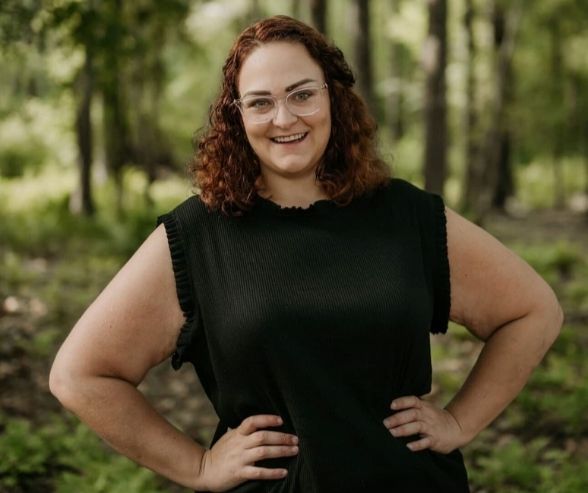
Sarah Christopher is a certified International Event and Wedding Planning Professional™ (IEWP™) whose passion for event planning began while organizing her own wedding. After graduating from QC Event School’s Event & Wedding Planning program, she founded Cheers & Champagne in January 2019; a business dedicated to helping couples bring their unique visions to life through full planning and coordination services. Sarah loves that no two events are ever the same and finds joy in seeing each celebration reflect her clients’ personalities. Warm, creative, and detail-driven, she strives to make every couple feel supported and stress-free throughout the process.
What Is a Fundraiser?
Before we dive into the details, let’s first start with the basics. A fundraiser is an organized effort to raise money or donations for a cause. They can be large or small, formal or casual, in person or virtual. Fundraisers might be community events like auctions and walkathons, or simple grassroots campaigns like bake sales or family fundraisers.
The key is that every fundraiser has a clear goal, a cause, and a plan to connect with supporters.
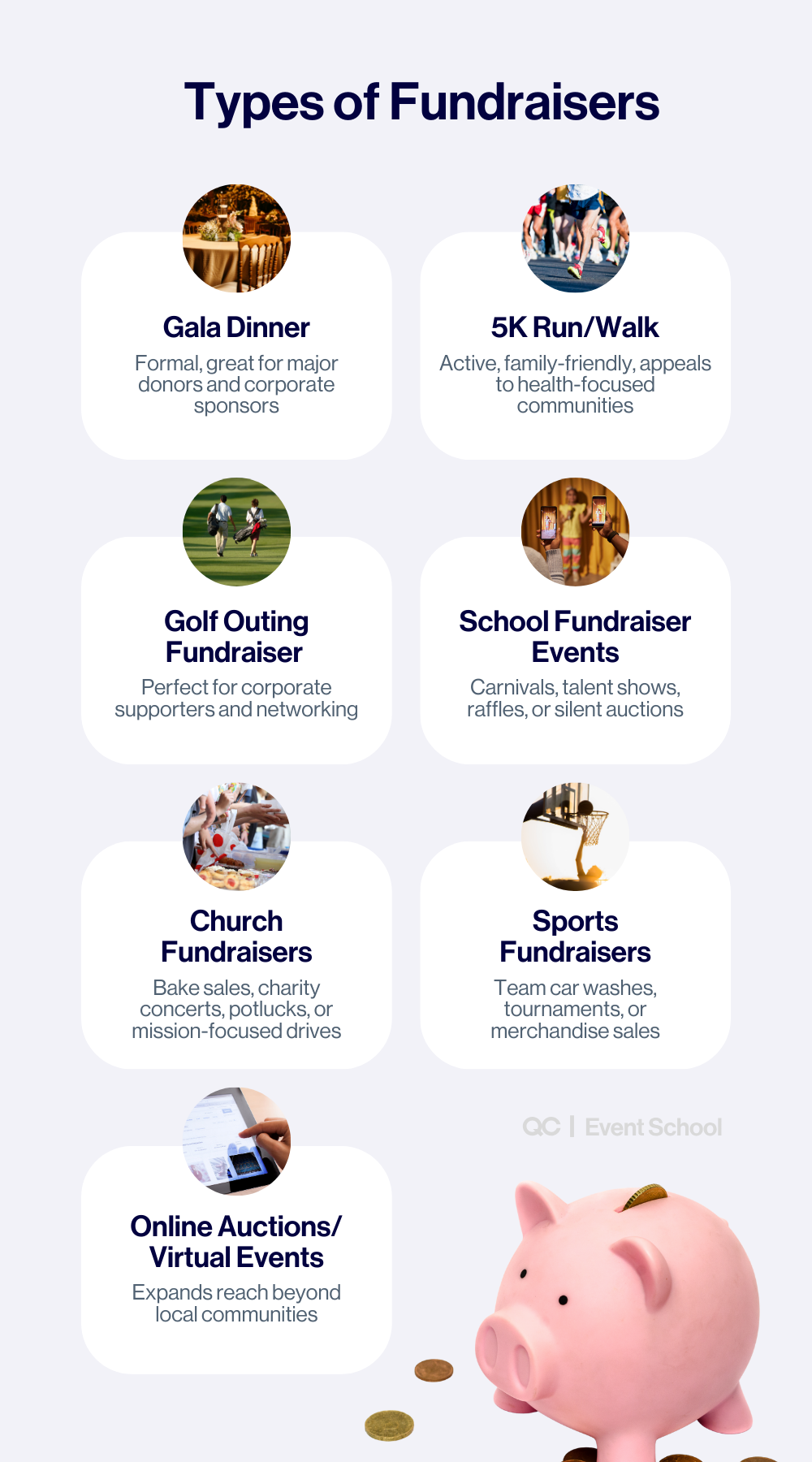
Why Fundraisers Matter
Fundraisers are more than just money-making events. They:
- Help build awareness for a mission or cause.
- Bring people together for a shared purpose.
- Strengthen relationships with donors, sponsors, and volunteers.
- Provide an opportunity to tell stories that inspire giving.
- Create a sense of community pride and involvement.
How Fundraisers Connect To Charity Events
When people think about how to organize a charity event, they’re really asking how to plan a fundraiser. Charity events are one of the most popular fundraiser types. They can include dinners, concerts, golf outings, or even hybrid online events.
Each type of fundraiser has its own planning needs, but the foundation is the same:
- Define your mission.
- Set clear goals.
- Choose the right format for your audience.
- Plan the details to maximize impact.
By the end of this article, you’ll see that fundraising is not only doable but VERY exciting. With the right tools and strategy, you can create an event that truly makes a difference!
How To Plan a Fundraiser: What Are The Core Elements Of A Good Fundraising Strategy?
Every strong fundraiser starts with a solid strategy. Think of it as the blueprint for your event! Without these core elements in place, you risk confusion, wasted money, and poor results. But with them, you can keep your team organized, impress donors, and reach your goals.
Let’s break down the essential components that every fundraising strategy should include.
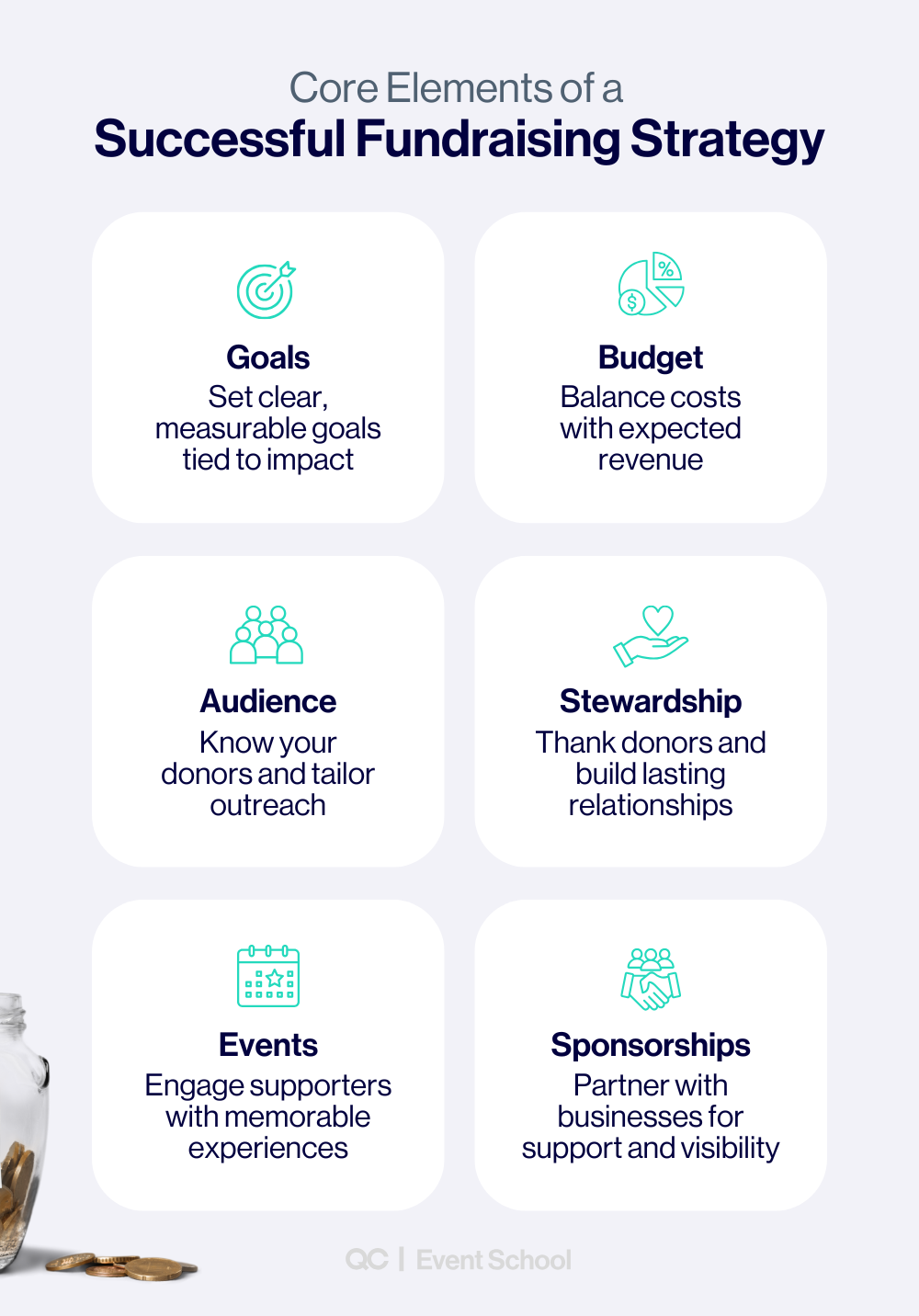
Goals And Benchmarks
The very first step in building a strategy is setting goals. Goals give your fundraiser purpose, and benchmarks help you measure progress along the way.
When setting goals:
- Be specific. Don’t just say, “We want to raise money.” Say, “We want to raise $15,000 to support new sports equipment for the school.”
- Make them measurable. Tie each goal to a number. It might be the amount of money raised, the number of new donors, or the number of participants at your event.
- Keep them realistic. Lofty goals can inspire people, but if they’re too high, they can also discourage your team and your donors.
- Tie them to your mission. Show how the money raised connects to real impact. Donors want to know exactly what their support will accomplish.
Goals are also motivational. Post progress updates on social media and/or at the event using thermometers, leaderboards, or live announcements. This keeps donors engaged and encourages last-minute giving.
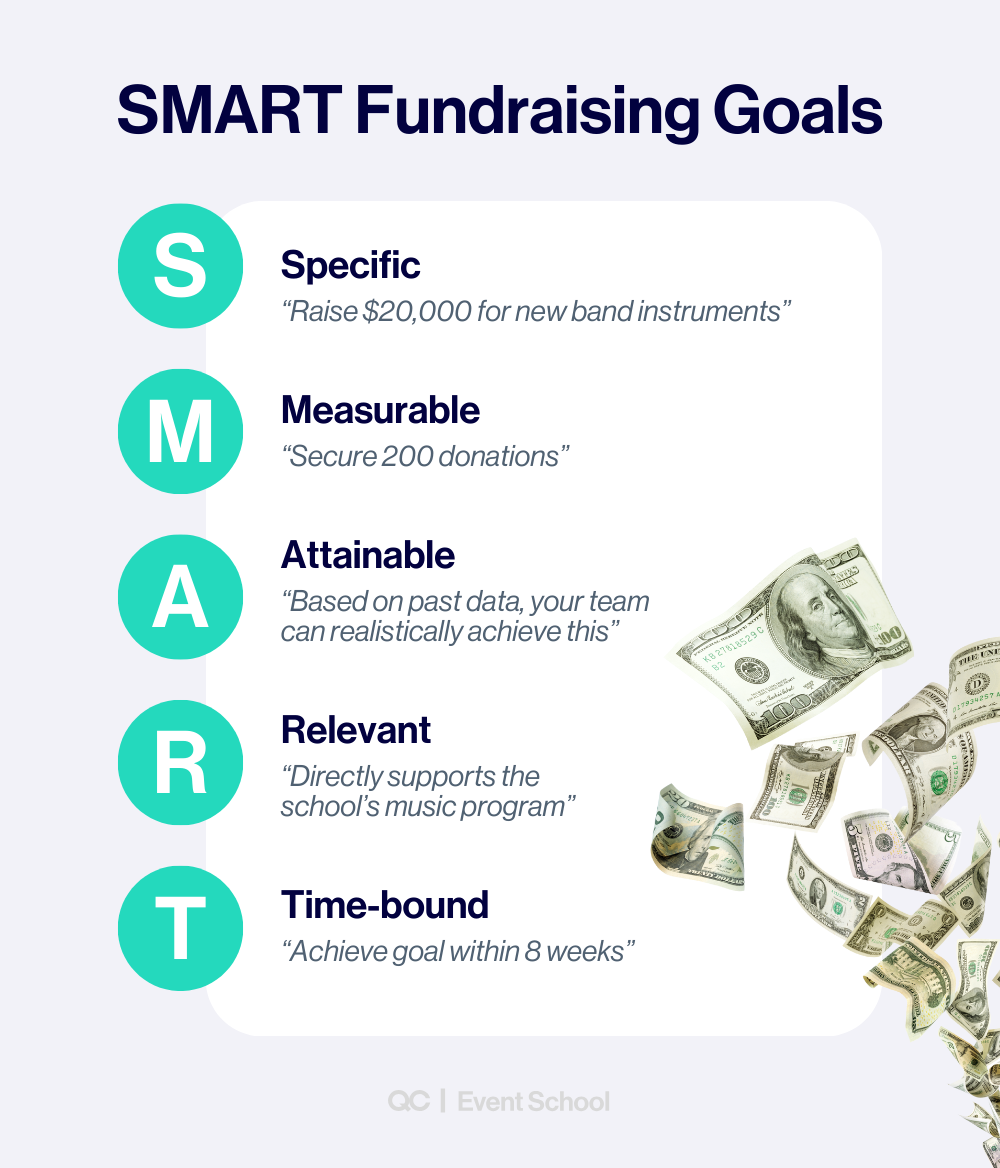
EXAMPLE
A school fundraiser might set a goal of $10,000 to renovate the library. Benchmarks could include signing up 100 participants in the first two weeks, securing five corporate sponsors by the one-month mark, and raising 50% of the funds before the event date.
Budget And Resources
Next, it’s critical to understand that fundraising costs money before it makes money. As such, setting a realistic budget ensures that your expenses don’t outweigh your donations.
Your Budget Should Include:
- Venue costs. Rental fees, permits, insurance, or outdoor space rentals.
- Food and beverage. Catering, snacks, drinks, or even volunteer-provided meals.
- Marketing. Flyers, posters, digital ads, email campaigns, or boosted social media posts.
- Technology. Online donation platforms, event registration tools, credit card processing fees, or text-to-give services.
- Entertainment. Live music, speakers, DJs, or activity rentals.
- Decorations and supplies. Tablecloths, signage, raffle tickets, or prizes.
- Staffing. Paid staff if needed, but don’t forget the value of volunteers.
Importantly, resources go beyond money, too. They also include:
- Volunteers. Friends, families, or community members willing to help with setup, check-in, or cleanup.
- Connections. Board members or supporters who can open doors to sponsors, donors, or media coverage.
- In-kind donations. Businesses may donate goods (like raffle items) or services (like printing flyers).
Audience And Outreach
No fundraiser succeeds without people! Understanding your audience ensures you design an event that speaks to them.
Ask Yourself:
- Who are the people most likely to support this cause?
- Where do they spend their time? Online or offline?
- What motivates them to give—fun, community, faith, competition, or recognition?
EXAMPLES
- Sports fundraiser: Target families of athletes, alumni, and local sports fans. Reach them through team email lists, social media groups, or announcements at games.
- Church fundraiser: Engage members of the congregation, their families, and the wider faith community. Outreach may include church bulletins, announcements at services, or word-of-mouth through small groups.
- School fundraiser: Parents, teachers, alumni, and even local businesses who want to support education. Communication may include newsletters, school social media, and parent-teacher associations.
Matching your marketing to your audience is vital. A younger crowd might respond better to TikTok videos and Instagram stories. On the other hand, older supporters may prefer phone calls, mailed letters, or church announcements.
Donor Stewardship
Raising money is only part of the process. Stewardship is about building lasting relationships with donors so they continue supporting your cause long after the event ends.
Good Donor Stewardship Includes:
- Immediate thank-yous. Always acknowledge gifts quickly. A short thank-you note, email, or call goes a long way.
- Sharing impact. Let donors know exactly how their money was used. For example, “Your donation helped us purchase 200 new books for the school library.”
- Regular updates. Keep donors connected throughout the year. Share stories, photos, or videos that show the real difference their support makes.
- Invitations to future events. Donors are more likely to give again if they feel involved.
Stewardship builds loyalty. A donor who feels appreciated may give again, give larger gifts, or even bring friends to your next fundraiser.
Events And Engagement
The fundraiser itself is your chance to engage people face-to-face (or virtually). Events create energy and excitement around your cause.
Types of Events Include:
- Galas or dinners (great for large donations and corporate sponsorships).
- 5K races or walkathons (good for schools, health causes, or sports teams).
- Golf outings (popular with corporate donors and community members who enjoy networking).
- Bake sales or raffles (easy for schools and churches).
- Virtual auctions or livestream concerts (broaden your reach beyond your community).
No matter the type, make sure your event is:
- Mission-driven. Highlight your cause throughout the event with speeches, videos, or displays.
- Engaging. Include activities, contests, or entertainment to keep people excited.
Interactive. Offer ways to donate during the event — mobile bidding, text-to-give, or QR codes on printed materials.
Corporate Sponsorships
Local businesses can provide valuable support. A corporate sponsorship allows a company to give money or services in exchange for recognition.
Benefits For Your Fundraiser:
- Sponsors help cover costs, so more of the money raised goes directly to your cause.
- They add credibility to your event. People are more likely to trust and support a fundraiser backed by a known business.
- They can provide goods, services, or volunteers in addition to cash.
How To Attract Sponsors:
- Identify companies that align with your mission. For example, a sporting goods store may sponsor a youth sports fundraiser.
- Create sponsorship packages with clear benefits (logo placement, social media mentions, speaking opportunities).
- Show sponsors the value (e.g., number of attendees, community reach, or local media coverage).
- Follow up with a thank-you and report on how their support made a difference.
💚 Become a Professional Event Planner!
Get trained, certified, and ready to book your first client in just 3 months, all while training at home with the help of QC Event School.
How To Create A Fundraising Strategy In 10 Steps
Creating a fundraising strategy gives you a clear plan to follow from start to finish. It turns a big idea into manageable steps. These 10 steps will help you build a strong foundation and stay organized as you prepare for your fundraiser.
Step 1: Review Past Fundraising Efforts
Before you look forward, take a look back. Past events hold valuable lessons that can guide your next campaign.
- What worked well? Did you hit your donation goals?
- What challenges came up? Did you overspend in certain areas?
- Which marketing channels brought in the most donors?
- Were there enough volunteers? Did they feel supported?
- How did donors respond? Were they engaged and willing to give again?
EXAMPLE
A school fundraiser may have sold raffle tickets one year and raised $5,000. Reviewing the numbers shows ticket sales were strong, but follow-up with donors was weak. That insight helps the school improve stewardship next time.
Step 2: Define Strategic Goals And Benchmarks
Goals give your fundraiser direction. Without them, it’s like driving without a map. Use the SMART goal framework (Specific, Measurable, Attainable, Relevant, Time-bound).
- Specific: “Raise $20,000 for new band instruments.”
- Measurable: “Secure 200 donations.”
- Attainable: Based on past data, your team can realistically achieve this.
- Relevant: Directly supports the school’s music program.
- Time-bound: “Achieve goal within 8 weeks.”
Benchmarks help track progress along the way. For example:
- 25% of funds raised by week 2
- 50% raised by week 4
- 75% raised by week 6
Step 3: Set A Fundraising Budget
Every fundraiser requires spending money to make money. A budget ensures your campaign is financially sustainable. Typical expenses include:
- Venue rental or permits
- Food, drinks, and catering
- Marketing (flyers, social media ads, press releases)
- Technology (donation platforms, event software, payment processing fees)
- Entertainment or guest speakers
- Decorations, signage, supplies
- Staff or security if required
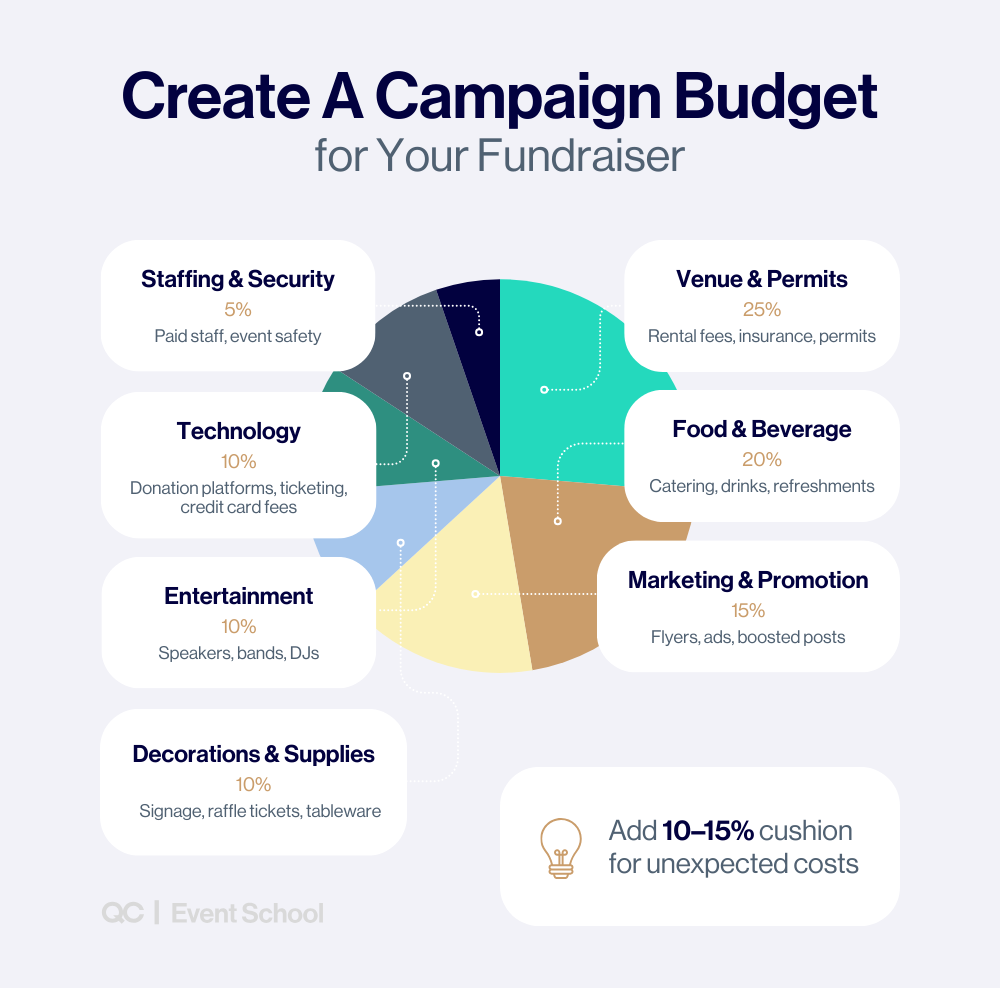
EXAMPLE
A sports fundraiser might budget $8,000 for venue and equipment, $2,000 for marketing, and $1,500 for refreshments. With expected donations of $20,000, the event should net at least $8,500.
Step 4: Build A Campaign Calendar
Timing is EVERYTHING! A calendar keeps your team on schedule and prevents last-minute stress.
Here’s a sample 12-week calendar:
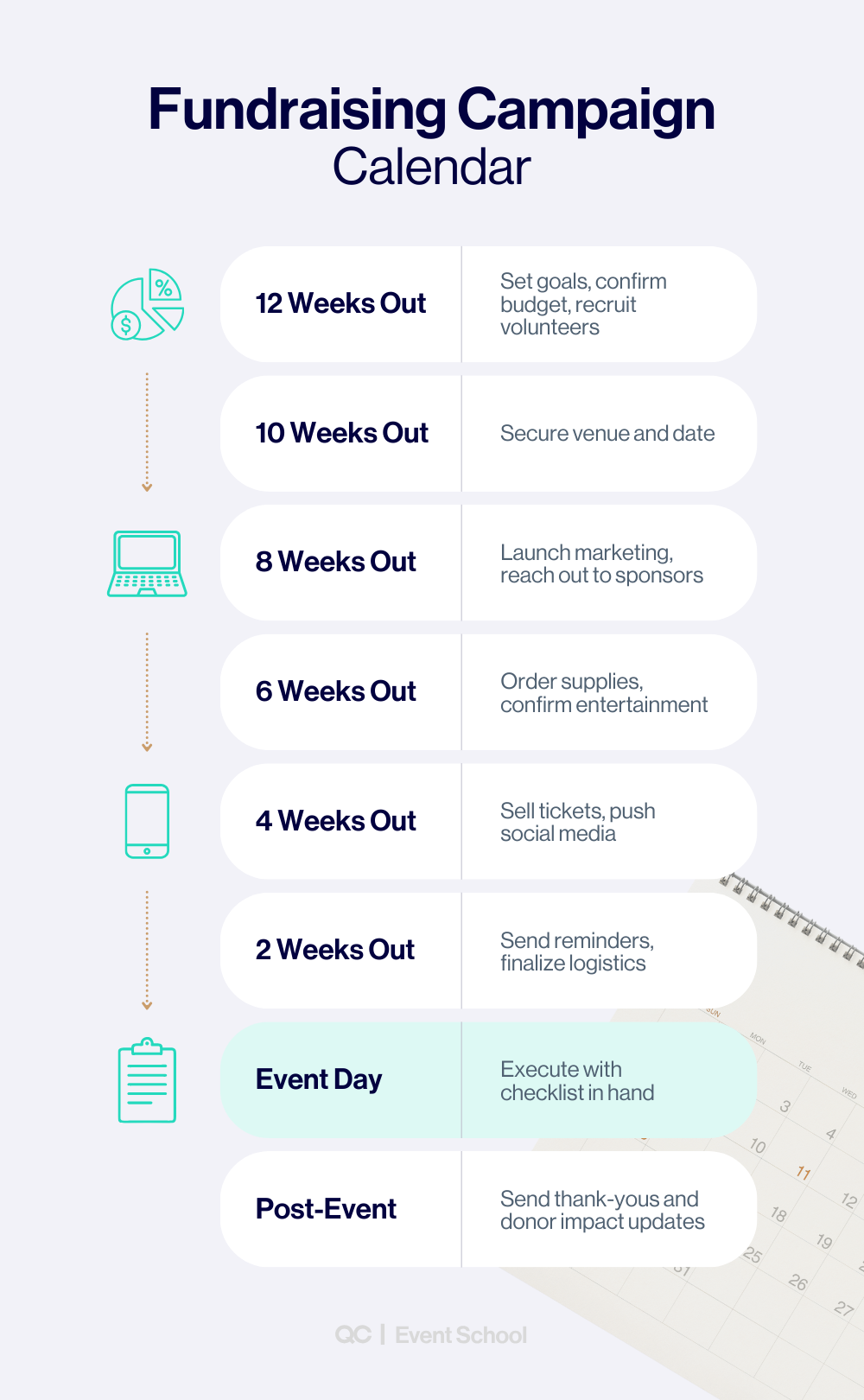
Step 5: Conduct Prospect Research
Not all donors are equal. Prospect research helps you identify those most likely to give large gifts.
Look for three markers:
- Capacity (Wealth): Can the donor afford to give?
- Affinity (Warmth): Do they care about your cause?
- Propensity (Habit): Do they already give to nonprofits or attend events?
EXAMPLE
A local business owner who regularly sponsors youth programs has both the capacity and the affinity to support a school fundraiser.
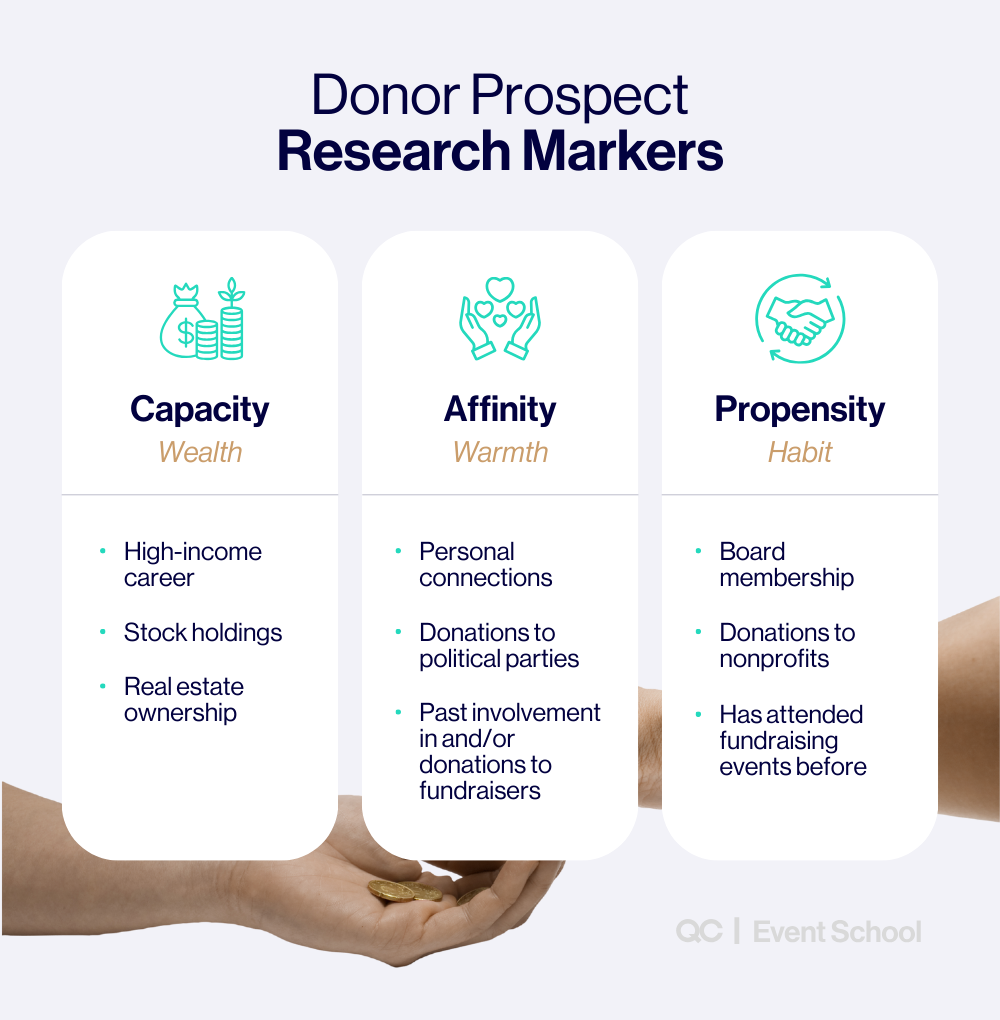
Step 6: Draft Your Case For Support
A “case for support” explains why people should give. It’s your story AND your pitch rolled into one.
Strong Cases Include:
- Your mission and why it matters
- The specific project or goal of the fundraiser
- The impact donors will make
- Emotional stories that connect supporters to the cause
EXAMPLE
Instead of saying, “We need funds for the football team,” say, “Your donation helps 50 student athletes access safe equipment, build teamwork skills, and represent our school with pride.”
Step 7: Choose Your Tools And Technology
Technology can make fundraising easier and more successful. The right tools save time, improve donor experience, and boost revenue.
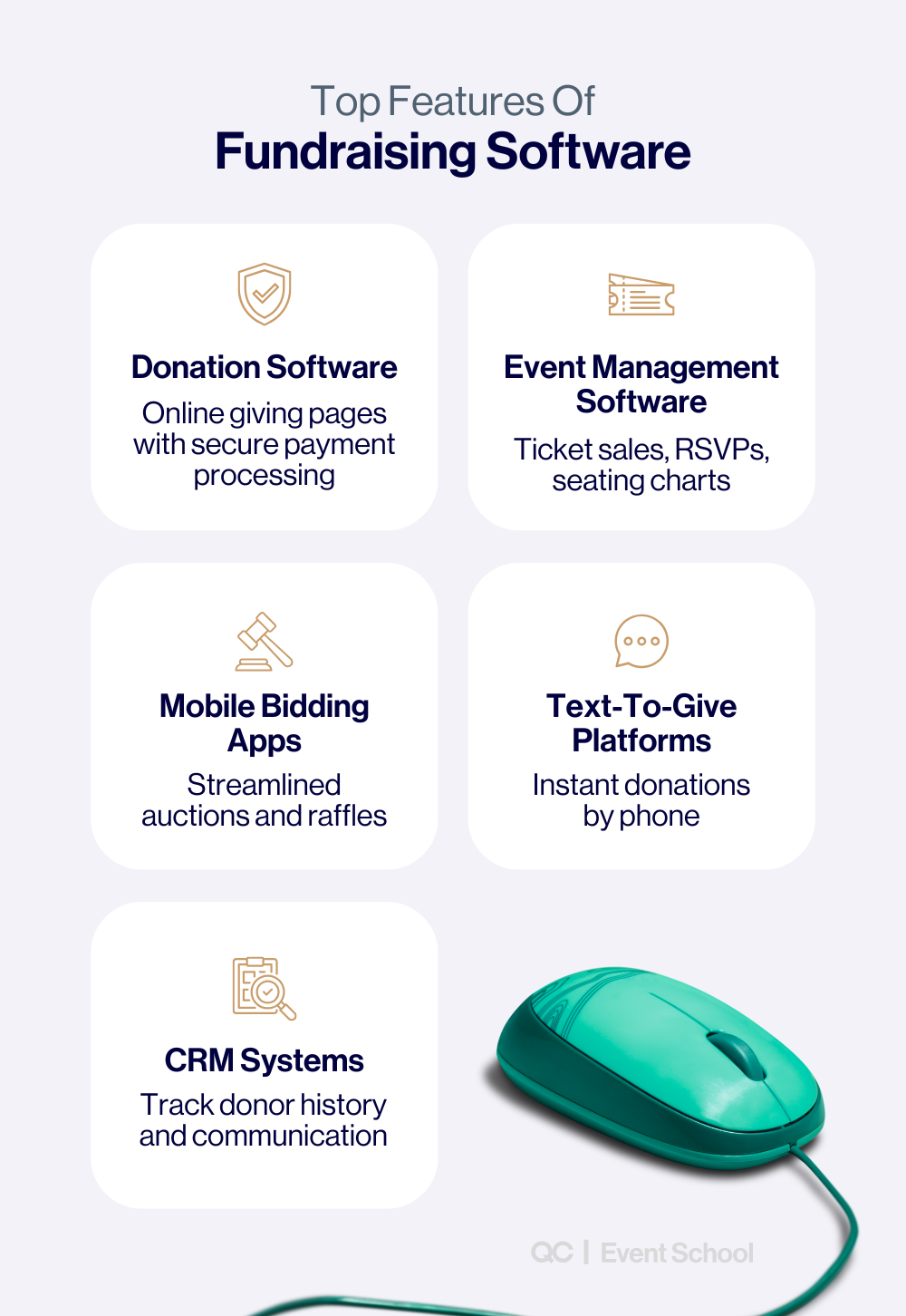
Essential Tools:
- Donation software → Online giving pages, secure payment processing.
- Event management software → Ticket sales, RSVPs, seating charts.
- Mobile bidding apps → For auctions and raffles.
- Text-to-give platforms → Donors give instantly by phone.
- CRM systems → Track donor data and communication.
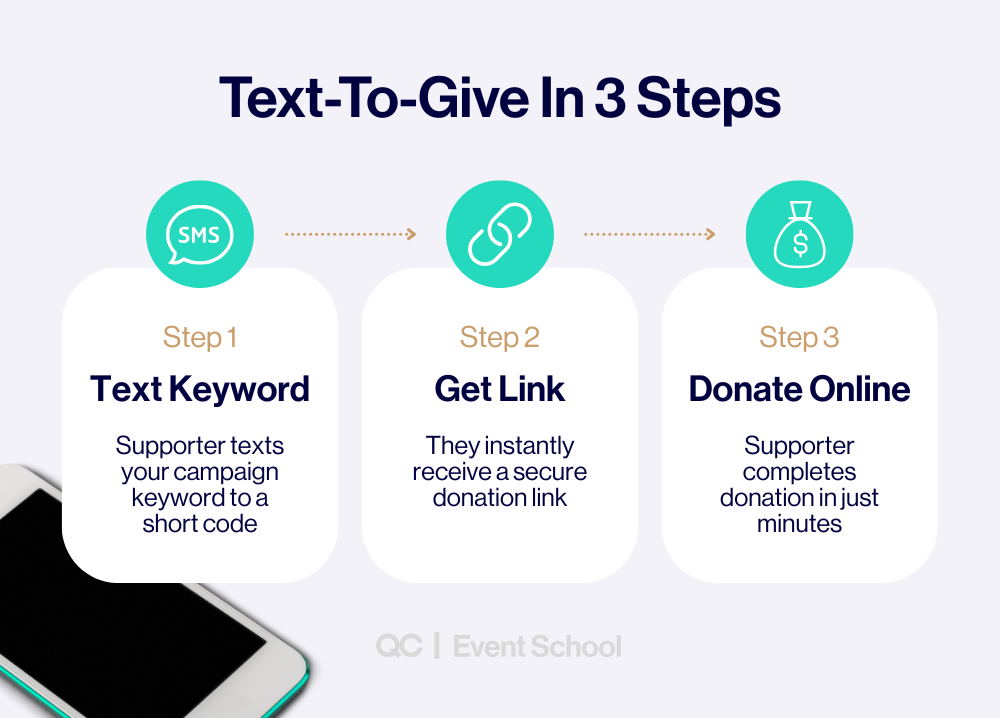
Step 8: Plan Donor Stewardship
Donor stewardship should not wait until after the event. Plan it into your strategy from the beginning.
Ways To Steward Donors:
- Before the event: Send previews, thank early donors, highlight sponsors.
- During the event: Publicly recognize top donors, thank volunteers, create a donor wall.
- After the event: Send personal thank-you notes, impact reports, and future invitations.
Strong stewardship builds donor loyalty and keeps people giving year after year.
Step 9: Build Your Campaign Roadmap
Your roadmap is the big-picture view of the campaign. It combines goals, budget, timeline, outreach, and stewardship into one document. Think of it as your master guide.
If questions come up— “Are we on budget?” or “When do sponsor emails go out?”—the roadmap has the answers!
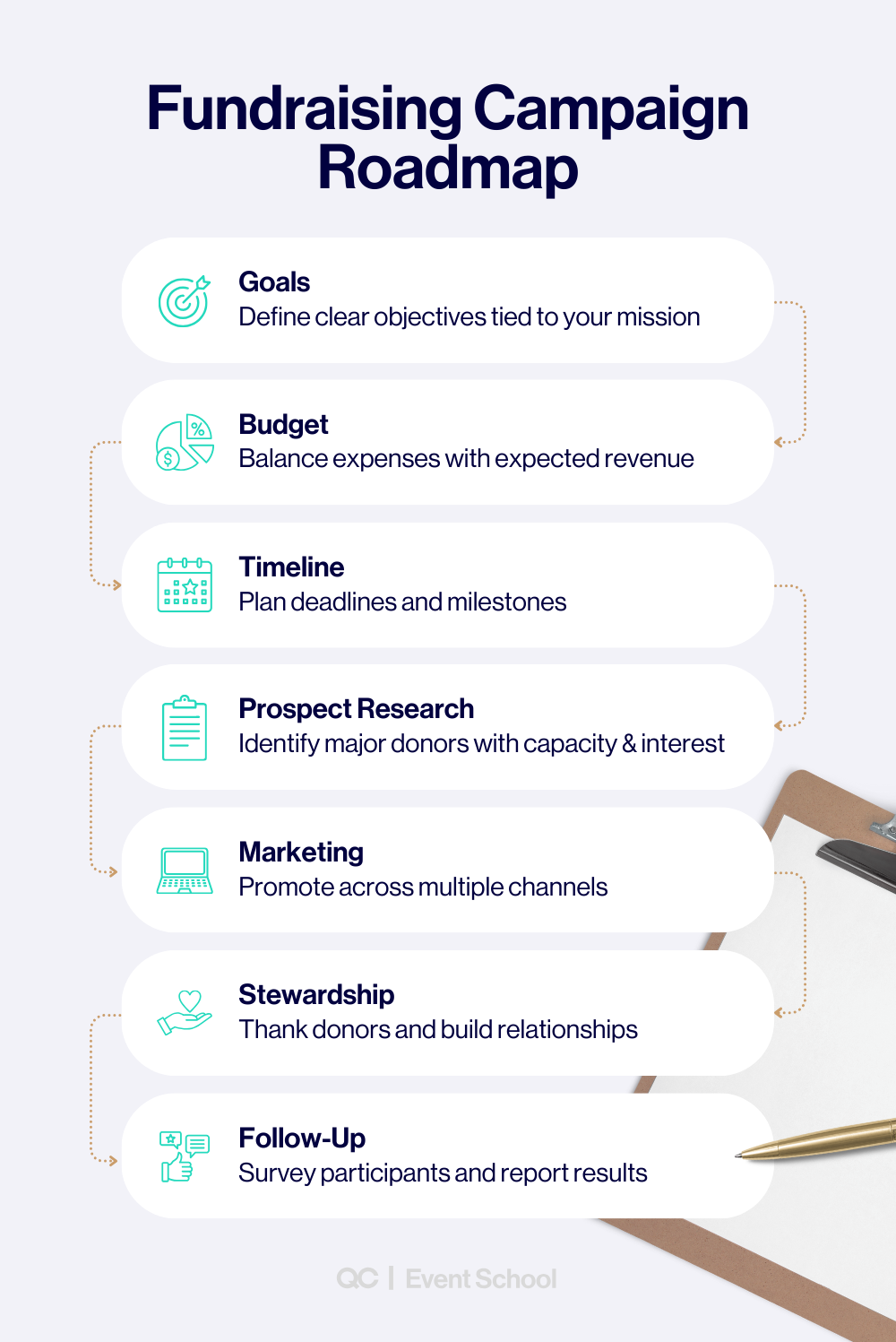
Step 10: Track KPIs And Plan Improvements
You can’t improve what you don’t measure. Key performance indicators (KPIs) help you evaluate success.
Common KPIs Include:
- Total funds raised vs. goal
- Number of new donors acquired
- Donor retention rate
- Average gift size
- Event attendance and participation
- Cost per dollar raised
After the fundraiser, gather your team for a debrief. Celebrate wins, identify challenges, and record lessons for next time.
EXAMPLE
If your cost per dollar raised was $0.40, that means for every $1 earned, $0.40 went to expenses. Your goal next time may be to lower that to $0.30 by securing more sponsors.
How To Plan A Fundraiser In 10 Steps
Once your strategy is in place, it’s time to plan the actual event! These 10 steps cover everything from setting goals to thanking your donors afterward. Think of this as your step-by-step roadmap to organizing a successful fundraiser.
Step 1: Choose A Clear Goal And Purpose
Every fundraiser should start with a purpose. What exactly are you raising money for, and why does it matter? Clear goals make it easier to motivate donors and measure success.
- Define the financial target (e.g., “Raise $25,000 for new playground equipment”).
- Connect it to your mission (“This will benefit 400 students each year”).
- Set additional goals, such as gaining 100 new donors or increasing social media reach.
EXAMPLE
A family fundraiser might aim to raise $10,000 for medical expenses. Alternately, a school fundraiser could set a goal of $15,000 for classroom technology.
Step 2: Select The Right Type Of Fundraiser
Not all fundraisers are the same. Choosing the right type depends on your audience, resources, and cause.
Popular Types of Fundraisers Include:
- Gala Dinner → Formal, great for major donors and corporate sponsors.
- 5K Run/Walk → Active, family-friendly, appeals to health-focused communities.
- Golf Outing Fundraiser → Perfect for corporate supporters and networking.
- School Fundraiser Events → Carnivals, talent shows, raffles, or silent auctions.
- Church Fundraisers → Bake sales, charity concerts, potlucks, or mission-focused drives.
- Sports Fundraisers → Team car washes, tournaments, or merchandise sales.
Online Auctions/Virtual Events → Expands reach beyond local communities.
Step 3: Know Your Audience
Understanding your audience helps you design a fundraiser that resonates.
- Who are your likely supporters? Families, businesses, alumni, faith groups?
- What motivates them? Fun, networking, competition, recognition?
- Where do they spend time? Social media, church, schools, sports fields?
EXAMPLE
For a sports fundraiser, alumni and local businesses might be your biggest donors. For a church fundraiser, your congregation and their families will be your primary base. No matter what, tailor your event and marketing to your audience for maximum impact.
Step 4: Find A Venue (Physical Or Virtual)
Your venue sets the tone for the fundraiser. It also impacts attendance, accessibility, and cost. Just make sure that you always have a backup plan for outdoor events in case of bad weather.
Venue Considerations:
- Size: Will it hold your expected crowd comfortably?
- Location: Is it easy to find and accessible for all ages?
- Amenities: Does it provide parking, AV equipment, tables, and chairs?
- Cost: Can you negotiate discounts for nonprofits?
EXAMPLE
A 5K fundraiser needs outdoor permits and a mapped route. On the other hand, gala dinners need a banquet hall or hotel ballroom, whereas a virtual auction needs reliable livestream and bidding software.
Step 5: Recruit A Planning Committee And Volunteers
A fundraiser takes a team. Divide responsibilities so no one person is overwhelmed.
Key Committee Roles Include:
- Event Chair: Oversees the entire fundraiser.
- Logistics Lead: Venue, permits, equipment.
- Sponsorship Lead: Approaches businesses and corporate donors.
- Marketing Lead: Social media, flyers, press.
- Volunteer Coordinator: Recruits and manages helpers.
- Finance Lead: Tracks donations, ticket sales, and expenses.
Volunteers Can Help With:
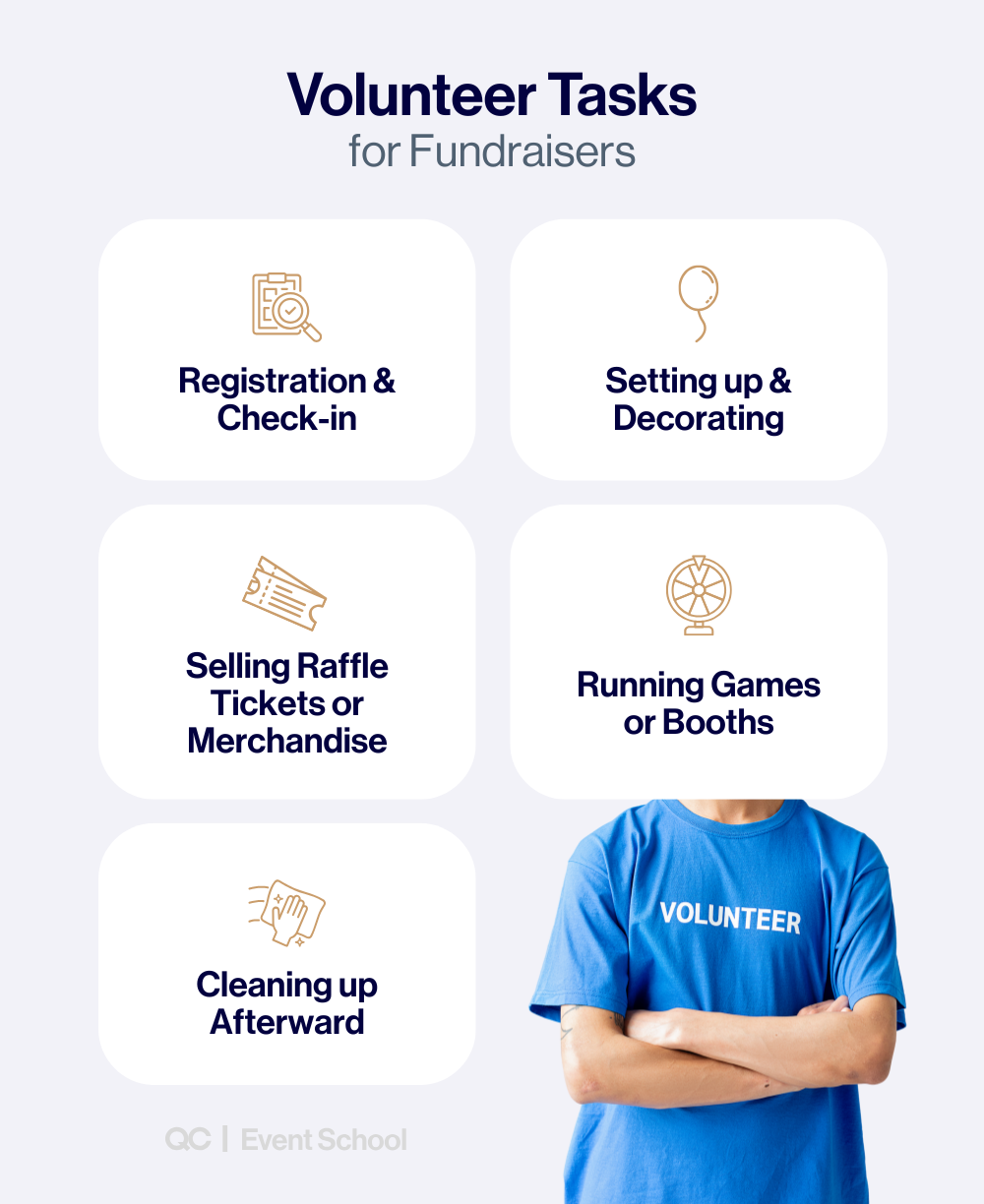
Step 6: Secure Corporate Sponsors
Sponsorships reduce costs and boost credibility. Luckily, companies often want to support community causes, especially when it aligns with their values.
How To Attract Sponsors:
- Identify businesses connected to your cause.
- Offer tiered sponsorship packages (Gold, Silver, Bronze).
- Provide benefits: logo placement, speaking opportunities, social media mentions.
- Share past success stories to show the value of sponsoring.
EXAMPLE
A local bank might underwrite a school fundraiser. A sporting goods store may provide equipment for a sports fundraiser.
Step 7: Market Your Fundraiser
Think about it: if people don’t know about your event, they can’t attend. Strong marketing ensures high turnout and donations. We recommend using multiple channels to reach ALL age groups.
Marketing Channels To Use:
- Social media (Instagram, Facebook, TikTok)
- Email newsletters
- Flyers and posters in the community
- Press releases to local newspapers and radio
- Personal outreach by volunteers
- Google Ad Grants for nonprofits (up to $10,000/month in free ads)
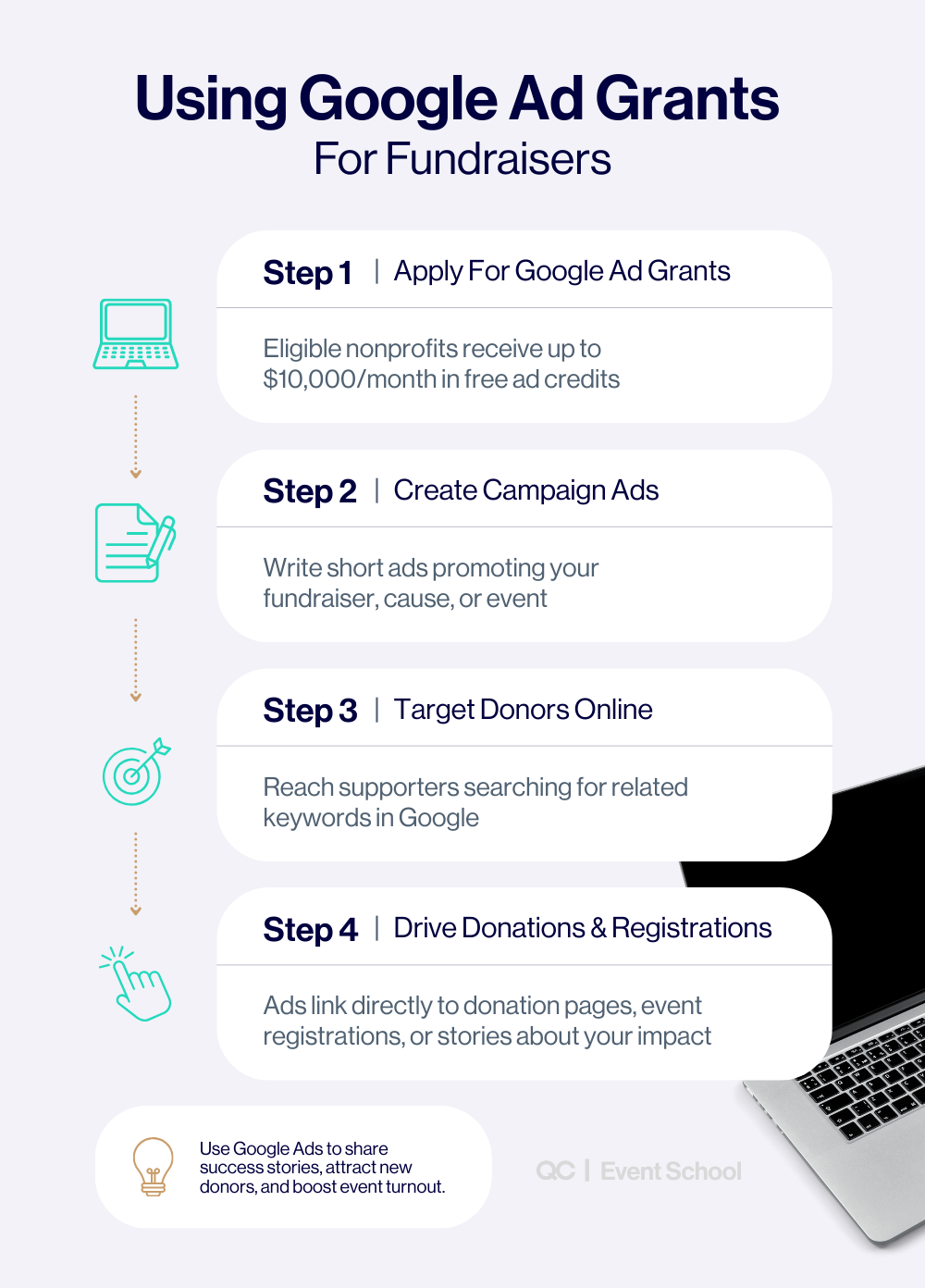
Step 8: Sell Tickets And Registrations
Ticket sales are a major revenue stream for many fundraisers, and there are many ways to make this process simple and flexible. For instance, you can:
- Offer tiered packages (General Admission, VIP, Family Pass).
- Provide early-bird discounts to encourage fast sign-ups.
- Make it easy to register online, with mobile-friendly forms.
- Collect attendee data (emails, phone numbers) for future outreach.
EXAMPLE
For a gala, you could sell tickets at $75 each or offer a VIP package at $150 with premium seating. For a 5K, you could charge $25 per runner, with discounts for families.
Step 9: Prepare For Event Day
Event day is showtime, and proper preparation ensures everything runs smoothly!
Checklist for Success:
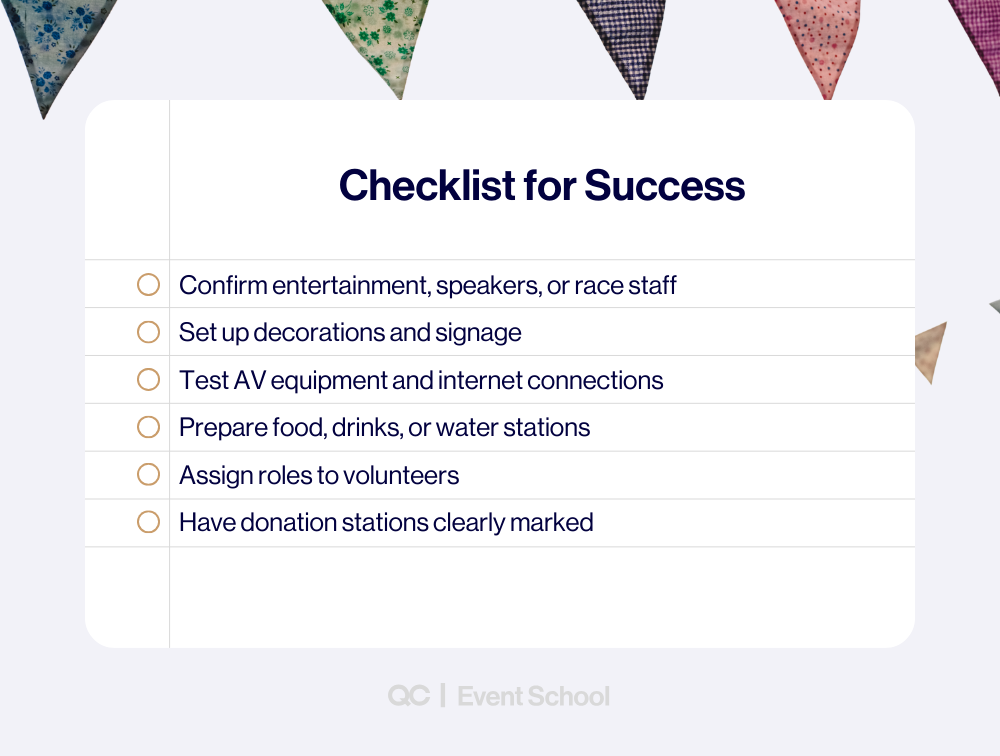
Step 10: Thank Donors And Follow Up
Just because the event ended DOESN’T mean the fundraiser is over! Rather, donor appreciation and follow-up are both critical because they keep momentum alive.
Best Practices:
- Send thank-you notes within 48 hours.
- Share results: “Together we raised $20,500!”
- Highlight impact with photos and stories.
- Survey attendees for feedback.
- Invite them to the next event.
Donors who feel valued are far more likely to give again to your causes in the future!
📅 Plan Unforgettable Fundraisers That Truly Make an Impact!
Gain the skills to design, coordinate, and manage charity events of any size with QC Event School’s Festivals and Live Events certification training.
How To Plan a Fundraiser: 10 Strategy Ideas To Set You Up For Success
Fundraising doesn’t only focus on the literal planning of the event. If you want to know how to plan a fundraiser successfully, you need to know these strategy ideas! They’ll help you maximize donations, build long-term donor relationships, and set your campaign apart.
Tip 1 – Cultivate Major Donors
Major donors often provide the bulk of funding. Thus, building relationships with them is one of the smartest moves you can make.
- Research potential donors through your network.
- Invite them to private events, tours, or one-on-one meetings.
- Personalize your asks based on their interests.
- Keep them updated with impact reports and personal thank-yous.
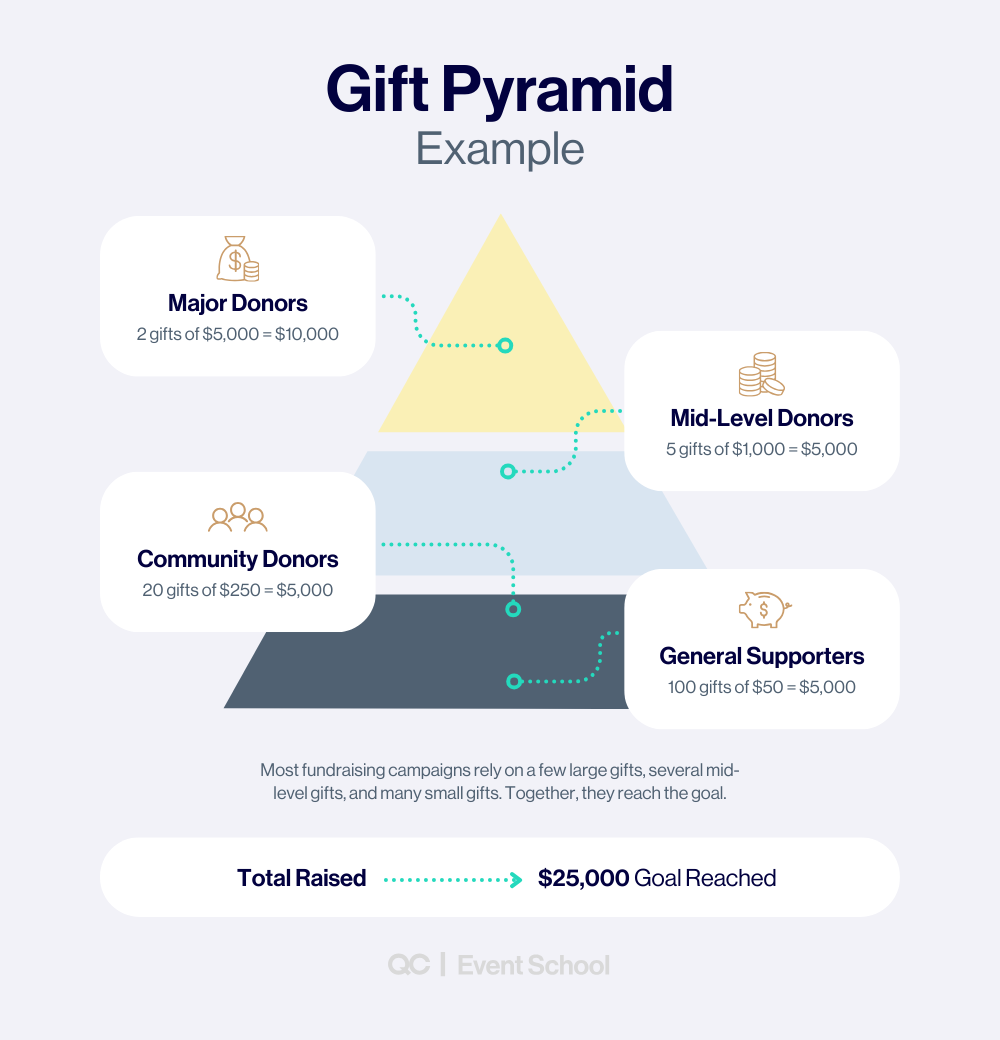
Tip 2 – Tell Your Story Through Impactful Marketing
People connect with stories more than statistics. Strong storytelling inspires donors to give.
- Share real stories of lives changed by your cause.
- Use photos and short videos to make it personal.
- Highlight a single student, family, or athlete to put a face to the mission.
Tip 3 – Launch A Recurring Giving Program
Recurring donors provide steady support. Even small monthly gifts add up over time.
- Offer a “Monthly Giving Club.”
- Provide perks, like special updates or recognition.
- Make sign-up simple on your donation page.
- Emphasize convenience: donors give once and it repeats automatically.
Tip 4 – Leverage Matching Gifts
Corporate matching doubles donations at no extra cost to donors.
- Educate supporters on how to check their eligibility.
- Provide a searchable database on your website.
- Promote matching during and after the fundraiser.
- Share stories of doubled impact: “Your $50 gift became $100 thanks to employer matching.”
Tip 5 – Partner With Local Businesses And Sponsors To Plan a Fundraiser
Sponsorship isn’t just for big events. If you want to know how to plan a fundraiser, one useful tip is knowing that even small fundraisers can benefit, too!
- Ask restaurants to donate a portion of sales on a certain night.
- Partner with a local gym to host a charity workout class.
- Request in-kind donations like raffle prizes, printing, or catering discounts.
- Give businesses recognition in your marketing.
Tip 6 – Host Regular Community Events
When you plan a fundraiser, consistency ALWAYS builds trust and recognition. Community events also create fun touchpoints outside of major campaigns.
Examples:
- Weekly yoga classes
- Family movie nights
- Book clubs or panel discussions
- Seasonal events like holiday markets or car washes
These keep your organization top-of-mind and build long-term loyalty.
Tip 7 – Embrace Hybrid AND Virtual Fundraising
Not all donors can attend in person. Hybrid and virtual events expand your reach.
- Livestream auctions or galas.
- Offer online ticket options.
- Use virtual bidding tools for raffles and auctions.
- Create hashtags and encourage online engagement.
Tip 8 – Tap Into Peer-To-Peer Campaigns
Empower supporters to raise money on your behalf.
- Provide templates for emails, texts, and social posts.
- Encourage participants to set personal fundraising pages.
- Recognize top fundraisers publicly.
- Add a leaderboard for friendly competition.
Tip 9 – Invest In Volunteer Engagement
Volunteers are potential donors and advocates for your business and overall cause!
- Train and appreciate them.
- Give them meaningful tasks, not just busy work.
- Highlight volunteer contributions publicly.
- Remember: 85% of volunteers also donate financially.
Tip 10 – Explore Niche Fundraisers
Think beyond the basics. Niche fundraisers can target specific audiences and stand out from the crowd!
Examples:
- How to organize a 5K fundraiser → Perfect for fitness communities.
- How to organize a golf outing fundraiser → Great for corporate networks.
- Sports fundraisers → Team tournaments, merchandise, or skills clinics.
- How to organize a fundraiser for a family → Personal, community-driven, and often highly successful.
- School fundraisers → Talent shows, silent auctions, or carnivals.
These niche options help you tailor events to your community’s needs and interests.
Common Mistakes To Avoid When Planning A Fundraiser
Even with the best intentions, fundraisers can fall flat if you overlook key details. The good news? Most mistakes are easy to avoid when you know what to look out for! Here are the most common pitfalls—and how to make sure they don’t derail your event.
Mistake 1 – Skipping Clear Goals
If you don’t know what success looks like, you can’t measure it! Too many fundraisers launch without setting specific, measurable goals.
- Wrong approach: “Let’s just raise as much money as we can.”
- Better approach: “We want to raise $20,000 for new school computers by June 1.”
👉 Clear goals motivate your team, inspire donors, and make follow-up easier.
Mistake 2 – Underestimating The Budget
Failing to budget properly is one of the biggest reasons fundraisers lose money.
- Overlooking hidden costs like permits, insurance, or credit card fees.
- Spending too much on extras like decorations or entertainment.
- Forgetting to add a 10–15% cushion for unexpected expenses.
👉 A well-planned budget ensures your fundraiser nets a healthy profit instead of breaking even.
Mistake 3 – Choosing The Wrong Type Of Fundraiser
Not every event works for every audience. Picking the wrong format can lead to low turnout and poor results.
- A formal gala won’t work for a youth soccer team.
- A bake sale won’t reach major corporate donors.
👉 Always match the fundraiser type to your supporters. A 5k run fits health causes, a golf outing suits corporate networks, and a church fundraiser works best for faith-based communities.
Mistake 4 – Weak Marketing And Promotion
You could plan the best event ever—but if no one knows about it, no one will come!
- Relying on just one channel (like Facebook posts).
- Waiting until the last minute to promote.
- Failing to create a strong event page or clear calls to action.
👉 Use multiple marketing channels such as social media, flyers, press releases, email, and word-of-mouth. The more people see your fundraiser, the more likely they are to show up and give.
Mistake 5 – Ignoring Donor Stewardship
Fundraising isn’t just about the event; it’s about building relationships. If you fail to thank and recognize donors, they may never give again.
- Skipping thank-you notes.
- Not showing donors how their money made an impact.
- Forgetting to invite them back for future events.
👉 Stewardship is just as important as planning. Always thank people quickly, share results, and keep donors connected year-round.
Mistake 6 – Overlooking Legal And Compliance Issues
Every fundraiser must follow the rules. Failing to do so can damage your reputation and/or even cause legal trouble.
- Not securing permits for raffles, auctions, or road races.
- Forgetting liability insurance for events.
- Failing to provide donation receipts for tax purposes.
👉 Always research your state and local regulations before hosting a fundraiser.
Mistake 7 – Failing To Debrief After The Event
Once the event ends, many groups move straight on to the next thing. But that’s a major faux pas!
- Teams miss chances to record lessons learned.
- Missed insights on what worked (or didn’t).
- No data collected for future planning.
👉 Always schedule a post-event debrief. Gather feedback from your team, donors, and volunteers. Use those insights to make your next fundraiser even stronger.
How To Plan a Fundraiser: Legal And Compliance Considerations
Yes, fundraisers are, in a big way, about raising money—but they also come with legal responsibilities. Overlooking compliance can lead to fines, legal trouble, or loss of donor trust. The good news is that most requirements are straightforward once you know what to look for!
Permits And Licenses
Certain fundraising activities require permits or special licenses, especially if money changes hands.
- Raffles and lotteries: Many states require a gaming or raffle license.
- Auctions: Some areas require special auction permits.
- Public events: Outdoor fundraisers often need event permits from the city or county.
- Food sales: Bake sales, dinners, or cookouts may require a food handling permit.
👉 Always check local and state regulations before advertising your event.
Tax Receipts For Donors
Donors expect to receive proper documentation for their gifts. This isn’t just good practice, though. In many cases, it’s the law.
- For donations over $250, provide a formal receipt.
- Receipts should include your organization’s name, donation amount, and a statement that no goods or services were received (if that’s the case).
- If donors receive something in return (like a gala dinner), note the fair market value of the benefit and the portion that is tax-deductible.
EXAMPLE
A donor pays $100 for a gala ticket. The dinner is valued at $40. Therefore, the receipt should state that $60 is tax-deductible.
Insurance And Liability
Events come with risks, which is why you absolutely have to protect your organization, your volunteers, and your donors.
- Event insurance: Covers accidents, property damage, or cancellations.
- Liability waivers: Important for athletic events like 5Ks or sports fundraisers.
- Vendor insurance: Ensure caterers, entertainers, or venues have their own coverage.
EXAMPLE
A 5K fundraiser should require participants to sign a waiver acknowledging the risks of physical activity.
Financial Transparency
Donors give because they trust your cause. Being transparent with finances builds credibility.
- Track every donation and expense carefully.
- Deposit funds into a separate, dedicated account if possible.
- Report totals honestly in post-event updates.
- Follow state rules on nonprofit financial reporting.
👉 Sharing a clear breakdown of how funds were used helps build donor loyalty and sets you apart from less professional fundraisers.
Accessibility And Inclusion
Legal compliance also means ensuring your event is accessible to everyone.
- Choose venues that are ADA-compliant.
- Provide virtual participation options when possible.
- Make donation tools mobile-friendly.
- Offer translation or interpretation if serving multilingual communities.
👉 Accessibility not only avoids legal issues, it also opens your fundraiser to a wider audience.
Final Thoughts: Become A Skilled Fundraising Event Planner
Planning a fundraiser takes effort, but the rewards are worth it!
From setting clear goals and building a budget to marketing, managing volunteers, and stewarding donors, every step helps you create an event that makes a real impact. The examples in this guide show how fundraisers of all kinds—school carnivals, 5K runs, church concerts, or family dinners—can succeed with the right plan. You’ve also learned about strategy essentials, legal compliance, and common mistakes to avoid.
Thus, with this knowledge, you’re ready to take your ideas and turn them into powerful, successful fundraising events!
But here’s the key: the best fundraisers don’t happen by chance. They happen when skilled event planners know how to organize every detail and lead with confidence.
Take The Next Step With QC Event School
At QC Event School, we know how important fundraisers are for communities, nonprofits, schools, and families. That’s why our self-paced, online Corporate Event Planning certification course gives you the hands-on training to:
- Plan events of any size, from small community fundraisers to large-scale festivals.
- Learn the ins and outs of budgeting, sponsorships, legal requirements, and marketing.
- Gain skills in vendor management, volunteer coordination, and donor engagement.
- Build a professional portfolio that sets you apart in the event industry.
Whether you want to plan a fundraiser for your own cause or add fundraising services to your event planning business, this course equips you with everything you need to succeed.

“QC Event School has the most comprehensive and legitimate event planning courses. I like that they have a community and help to connect you with prospective vendors, clients, and other students. The Corporate Event Planning course was incredibly useful to learn how to organize the individuals components of an event. I’ve also learned how to create more detailed and useful budgets and timelines.”
Jenny Trejo
International Corporate Event Planning Professional (ICPP)™ • Promotional Event Planning Student
Ready to turn YOUR passion for planning into a career? Enroll in QC Event School’s Corporate Event Planning course today, and start creating unforgettable fundraisers!
Helpful Resources
- Get Sponsorships for Festivals and Live Events with These 4 Tips
- How To Plan a Large Festival in 1 Year
- One Week Out: A Planner’s To-Do List
- 24 Hours Before The Event: The Planner’s Role
- Top Questions To Ask at Every Client Consultation (Free Download)
- Creating The Event Concept
- Setting Event Goals
- How To Find Clients
- Corporate Event Planning: Internal Events
- Corporate Event Management: External Events
FAQs About How To Plan A Fundraiser
We’ve covered the full roadmap, but you may still have questions. So, here are answers to some of the most common queries about how to plan a fundraiser.
What Is A Nonprofit Fundraising Strategy?
A nonprofit fundraising strategy is a detailed plan that guides how an organization raises money. It includes:
- Setting goals;
- Creating a budget;
- Choosing fundraiser types;
- Marketing, managing donors;
- And stewarding relationships.
A strong strategy helps nonprofits stay organized, measure results, and build long-term donor trust.
Why Is It Important For A Nonprofit To Have A Fundraising Strategy?
Without a strategy, fundraising efforts can be scattered and less effective. A strategy ensures:
- Clear goals and accountability.
- Efficient use of resources.
- Stronger donor relationships.
- Consistency from one campaign to the next.
- Better financial results and impact.
What Are The Different Types Of Fundraisers?
Fundraisers come in many forms, including:
- Gala dinners and auctions
- 5K fundraisers and walkathons
- Golf outing fundraisers
- School fundraisers (carnivals, raffles, talent shows)
- Church fundraisers (concerts, bake sales, mission drives)
- Sports fundraisers (tournaments, merchandise sales)
- Online or hybrid fundraisers (virtual auctions, livestream events)
What Is The Easiest Fundraiser To Organize?
The easiest fundraisers are simple, low-cost events such as:
- Bake sales
- Raffles (if permitted by local laws)
- Car washes
- Online crowdfunding campaigns
These require minimal setup and are perfect for small teams or community groups.
How Do You Plan A School Fundraiser?
- Set a clear goal (e.g., raise $10,000 for playground upgrades).
- Choose an event kids and families will enjoy (carnival, raffle, fun run).
- Involve parents, teachers, and local businesses.
- Use school newsletters and social media for promotion.
- Follow up with thank-yous and updates.
How Do You Organize A Church Fundraiser?
Church fundraisers often focus on community and fellowship. Steps include:
- Choosing an event that fits your congregation (concert, potluck, charity drive).
- Asking church members to volunteer or donate items.
- Promoting the fundraiser during services and through bulletins.
- Collecting freewill donations or charging a small admission fee.
- Thanking the congregation and showing how the funds were used.
How Do You Organize A Sports Fundraiser?
Sports fundraisers can be fun and competitive. Options include:
- Car washes run by the team
- Ticketed tournaments
- Merchandise or bake sales at games
- Sponsorships from local businesses
Engage athletes, parents, and alumni. Make sure funds go directly toward team needs, like uniforms or equipment.
How Long Does It Take To Plan A Fundraiser?
The timeline depends on the size of the event.
- Small events (bake sales, car washes): 2–4 weeks.
- Mid-size events (5K runs, auctions): 2–3 months.
- Large events (galas, festivals, golf outings): 4–6 months or more.
The more complex the event, the earlier you should start.
How Do You Budget For A Fundraising Event?
Start by listing all possible expenses, including venue, permits, catering, marketing, and technology. Add a 10–15% cushion for unexpected costs. Balance expenses with your revenue goal to make sure the fundraiser will net a profit.
What Is The Most Profitable Type Of Fundraiser?
Profitability depends on audience and resources, but typically:
- Galas and auctions bring in large donations through sponsorships and high-ticket sales.
- Golf outings can raise big money with corporate sponsors.
- Walkathons and 5Ks generate strong community participation.
- Online campaigns have low overhead and wide reach.
As we’ve mentioned, the key is matching the fundraiser type to your audience.
🙌 Plan Impactful Fundraisers That Achieve REAL Results!
Learn how to plan a fundraiser that strengthens brands, engages donors, and drives meaningful impact.

